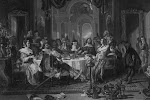
The Ancient Maya practiced certain rituals with the aid of hallucinogenic substances. Psychotropic flora and fauna used in a ritual context are termed entheogens and I wish to speak in particular about mushroom use. While deciphering the codices of the Maya is beyond my humble scholarly expertise, I believe that even a novice could make out the vaguely mushroom like apparatus wielded by the standing individual above.
This is the amanita muscaria, also known as fly agaric. The six bulbous protrusions appearing on the codex 'mushroom' have an uncanny resemblance to the white patches of the Amanita muscaria. The agaric is psychoactive and does indeed grow in the highland regions of Mesoamerica among pine forests.

Today A. muscaria is recognized by the Quiche-Maya as Cakuljd Ikox (lightning mushroom), hinting at it's supernatural qualities. It was termed Xibalba ikox in the Vico dictionary, a colonial account of indigenous words, meaning 'mushroom of the underworld'. In the Dresden codex, the mushroom is associated with the Mayan glyph cimi, the symbol for death. It becomes apparent that the mushroom has a intimate relationship with death, but the nature of that relationship is not so readily apparent.
Predominantly found in Guatemala the agaric is just one of several hallucinogenic fungi found in Central America. Ethnographic accounts reveal another fungus, Stropharia cubensis, that enjoys usage today by at least two Maya groups: the Ch'ol and Lacandon of Southern Mexico. S. cubensis is a dung fungus reliant on ruminant species: grass-eaters like camels, derr, bison, and sheep. In pre-Columbian Mesoamerica, deer were the only ruminant species capable of carrying and germinating the spores. With this in mind it is important to consider the deer and its nature in Maya iconography.

The deer is considered a being of the underworld and associated with hallucinations, trance-like states, and ritual performances. On this Maya vase, the central figure is a deer, performing some form of ritual amongst other anthropomorphic beasts. The figure on the left appears to be vomiting: a standard form of ritual purification. The individual on the right looks to be engaged in an enema. A fermented honey mead is thought to have been administered in this manner. That the deer is associated with these images suggests that it had some fundamental role in the ritual experience.
The mushroom, as seen in page XVIII of the Madrid Codex, held a unique niche in elite rituals. With its strong ties to death, it was a cosmic key, a device used to obtain ancestral authority for elite endeavours.







I have found plenty of evidence supporting the proposition that Mesoamerica, the high cultures of South America, and Easter Island shared, along with many other New World cultures, elements of a Pan American belief system so ancient that many of the ideas may have come from Asia to the New World with the first human settlers. I believe the key to this entire belief system lies, as proposed by Robert Gordon Wasson, in early man's discovery of the mind-altering effects of various hallucinatory substances. The accidental ingestion of these hallucinogenic substances could very well have provided the spark that lifted the mind and imagination of these early humans above and beyond the mundane level of daily existence to contemplation of another reality.
ReplyDeleteMy study of pre-Columbian art and iconography began in 1996, inspired by a theory first proposed over fifty years ago by my father, the late Maya archaeologist Dr. Stephan F. de Borhegyi, that hallucinogenic mushroom rituals were a central aspect of Maya religion. He based this theory on his identification of a mushroom stone cult that came into existence in the Guatemala Highlands and Pacific coastal area around 1000 B.C. along with a trophy head cult associated with human sacrifice and the Mesoamerican ballgame. Despite the reluctance of the archaeological community to accept a theory of a mushroom cult among the Maya, he supported his theory with a solid body of archaeological evidence as well as historical evidence found recorded in various Spanish chronicles and Aztec codices.
For more on this subject read BREAKING THE MUSHROOM CODE: by Carl de Borhegyi at mushroomstone.com
So, actually our gods/demons taking human form and giving superior orders creating new waves of "ILLUMINATI/PROPHETS etc..." were drugs/dragons taking control of our mind/body/spirituality and using/feeding on us, for their rebirths through human interactions?
ReplyDelete